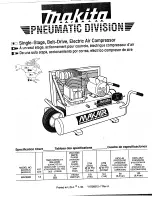
Hold Down Plate
Screw
Diaphragm
Connecting
Rod
Hold Down
Plate
DIAPHRAGM REPLACEMENT
1. Remove head.
2. Remove four screws from hold down plate. Discard screws.
3. Remove hold down plate, diaphragm and diaphragm liner (if present) from connecting
rod top. Wipe connecting rod top and hold down plate with a clean soft cloth.
4. Center new diaphragm and hold down plate over connecting rod holes. Make sure
all holes align as shown in the illustration below and that the diaphragm is centered
in the well of the housing. Insert four new screws. Torque screws to 20 in- lbs. in
criss-cross pattern.
5. Replace head and valve plate assembly. Torque screws to 40 in- lbs. in a criss-cross
pattern.
INTAKE & EXHAUST VALVE REPLACEMENT
1. Remove 4 head screws and head. Discard
screws. Turn head over. Remove 4 screws
from valve plate. Discard screws. Remove
valve plate from head. NOTE: If valve plate
needs to be pried out of head cavity, be careful
that the intake hole seat area does not get
damaged. If damage should occur the valve
plate will need to be replaced.
2. Remove and discard gasket.
3. Remove screw, flapper and keeper from top
side of valve plate, discard. Wipe valve plate
and head with a soft clean cloth. Reassemble
new flapper and keeper with new screw.
Torque to 10 in- lbs. Make sure the end of
the flapper covers the intake hole and that
the keeper is aligned properly. Turn valve
plate over and repeat procedure on exhaust
flapper.
4. Wipe inside of head with a clean soft cloth, be
sure to remove any excess gasket. Install new
gasket.
5. Replace valve plate in head. (See Fig. #1).
Insert 4 new screws. Torque valve plate
screws to 40 in- lbs.
6. Replace head. Torque screws to 48 in- lbs. in
a criss-cross pattern.
Valve
Keeper
Valve
Flapper
Gasket
Valve Plate
Screw
Head




















